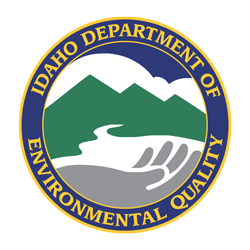| Data | Details |
|---|---|
| Hydrologic Unit Codes | 17040219 |
| Size | 1,496 square miles (957,495 acres) |
| Water Bodies with EPA-Approved TMDLs (Category 4a) | Big Wood River, Croy Creek, Eagle Creek, East Fork Wood River, Greenhorn Creek, Lake Creek, Magic Reservoir, Malad River, Quigley Creek, Rock Creek, Seamans Creek, Thorn Creek, Warm Springs Creek |
| Beneficial Uses Affected | Cold water aquatic life, salmonid spawning, primary and secondary contact recreation, drinking water supply |
| Major Land Uses | Range, forest, agriculture |
| Approved by EPA | May 2002 Approval Letter |
| Errata Approved by EPA | February 2012 EPA Approval Letter |
| Tributaries Temperature Addendum Approved by EPA | December 2013 EPA Approval Letter |
Subbasin Characteristics
The Big Wood River subbasin is located in south-central Idaho and is made up of three elevation-ecological areas in Blaine, Gooding, Lincoln, and Camas Counties. These areas include the Sawtooth National Forest (above 5,800 feet in elevation), the Wood River Valley (4,000–5,800 feet in elevation), and the agricultural area (below 4,000 feet elevation). The Wood River Valley has atypical ecological characteristics of the lower elevation area. All physical and biological characteristics of the Big Wood River subbasin are related to these elevation-ecological areas.
2002 Subbasin Assessment and TMDL
The overall purpose of this subbasin assessment and TMDL is to characterize and document pollutant loads within the Big Wood River subbasin. Twenty stream segments on the § 303(d) list were evaluated; an additional four stream segments that were not on the § 303(d) list were also evaluated.
The document recommends that four streams (Horse Creek, Owl Creek, Baker Creek, and East Fork Wood River) be removed from the § 303(d) list. These streams are meeting their beneficial uses and/or state water quality standards.
The document also recommends two additional stream segments be listed on the next § 303(d) list. The first is in the Big Wood River main stem from Base Line to Magic Reservoir. The second is in the Big Wood River main stem from Interstate 84 to the Snake River (or the Malad River).
TMDLs were established for sediment, nutrients, and bacteria. Flow alteration will be evaluated further. A TMDL was not being established at this time for streams polluted by nitrite + nitrate. Temperature and dissolved oxygen TMDLs will be deferred until 2003 pending collection of more information. A TMDL was not established for turbidity at this time since the sediment TMDLs will create reductions in turbidity. The TMDL recommends that ammonia be delisted as a pollutant of concern.
2002 TMDL: Streams and Pollutants for Which TMDLs Were Developed
| Stream | Pollutants |
|---|---|
| Big Wood River | Sediment, nutrients, bacteria |
| Eagle Creek | Sediment, nutrients |
| Lake Creek | Nutrients |
| Placer Creek | Nutrients |
| Cove Creek | Temperature |
| Greenhorn Creek | Sediment, nutrients |
| Quigley Creek | Sediment, nutrients |
| Seamans Creek | Sediment, nutrients |
| Rock Creek | Sediment, nutrients, bacteria |
| East Fork Rock Creek | Sediment, nutrients |
| Thorn Creek | Sediment, nutrients |
2011 Errata to the Big Wood River Watershed Management Plan
This document corrected calculation errors in four tables that appeared in the final Big Wood River Watershed Management Plan (a total maximum daily load, or TMDL), approved by the US Environmental Protection Agency (EPA) on May 15, 2002. The calculation errors were a result of not using the correct design flow capacity for three wastewater treatment plants (WWTPs). The errors did not come to light until a National Pollutant Discharge Elimination System (NPDES) draft permit reissuance for the City of Hailey. The City of Ketchum and the Meadows WWTPs were also affected. DEQ and EPA recognized the errors and DEQ corrected Table H, page xviii; Table XX, page 64; Table HHH, page 76; and Table PPP, page 89. The revised tables are included in this errata and supersede those in the 2002 TMDL.
2013 Addendum
This document addresses three water bodies in the Big Wood River subbasin that have been placed in Category 5 of the 2010 Integrated Report for temperature impairment. Temperature TMDLs were developed for two of these water bodies: Quigley Creek and Rock Creek. Effective target shade levels were established for Quigley Creek and Rock Creek based on the concept of maximum shading under potential natural vegetation resulting in natural background temperature levels. Black Canyon Creek was found to have insufficient water to be assessed. No sources or pathways of pollutants were identified for Black Canyon Creek and the two assessment units of this water body are proposed for delisting in the next Integrated Report cycle.
2013 Addendum: Streams and Pollutants for Which TMDLs Were Developed
| Stream | Pollutants |
|---|---|
| Quigley Creek | Temperature |
| Rock Creek | Temperature |
Subbasin Documents
- The Big Wood River Watershed Management Plan (May 2002)
- Big Wood River Watershed Total Maximum Daily Load: Implementation Plan for Agriculture (October 2006; Revised February 2014)
- Errata to the Big Wood River Watershed Management Plan (November 2011)
- Big Wood River Tributaries Temperature Total Maximum Daily Loads: Addendum to the Big Wood River Watershed Management Plan (October 2013)
- Big Wood River Watershed Management Plan: TMDL Five-Year Review (December 2017)
- Big Wood River Temperature Addendum Implementation Plan for Agriculture (2020)
This accordion will not appear on the screen

